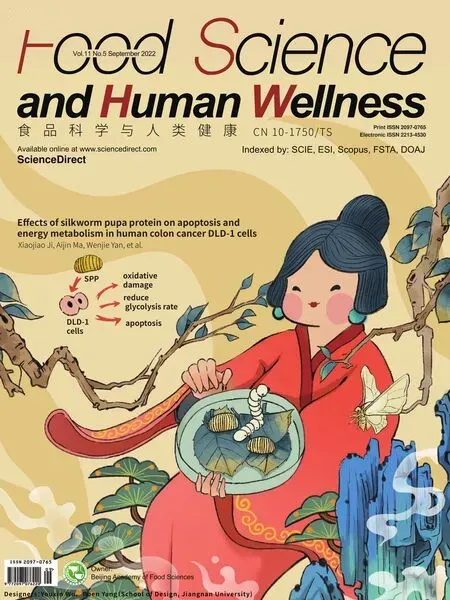A comprehensive review on the effects of green tea and its components on the immune function
Jichen Sun*, Shengjie Dong, Jinying Li Hui Zho
a School of Biotechnology and Food Science, Tianjin University of Commerce, Tianjin 300133, China
b School of Pharmaceutical Science and Technology, Tianjin University, Tianjin 300072, China
c Faculty of Education and Sports, Guangdong Baiyun University, Guangzhou 510450, China
Keywords:
Green tea
Active components
Innate immune system
Adaptive immune system
Intestinal immune system
A B S T R A C T
Green tea and its bioactive components possess many health-promoting and disease-preventing benefits,especially anti-inflammatory, antioxidant, anticancer, and metabolic modulation effects with multi-target modes of action. In contrast, the effects and mechanisms of tea and its components on the immune system are rarely reviewed. The stud y aimed to review the most potent compounds in tea that affect the immune systems and mechanisms associated with it. As a result of in vitro studies, animal models, and human trials, researchers have found that green tea extracts and compounds have the possibility of modulating the innate immune system, adaptive immune system, and intestinal immune system. In immune-related diseases, tea polyphenols are the most significant compounds that modify immune functions, though other compounds are being investigated and cannot be ruled out. The review provides a new perspective on how the immune-regulatory effects of tea and its components are exerted on immune systems, as well as how they affect the emergence and treatment of diseases.
1. Introduction
Both innate immune responses and adaptive immune responses make up the host immunity [1]. The former reacts rapidly and non-specifically to pathogens, whereas the latter responds in a slower but specific manner, with the generation of long-lived immunological memory [2]. Innate immunity is mediated by innate immune cell populations such as macrophages, natural killer cells, basophils,neutrophils, dendritic cells, mast cells, and eosinophils [3,4].Adaptive immunity is a relatively new evolutionary trait based on the immunoglobulin family and cells such as T and B cell [5].Moreover, the intestinal tract is considered the largest immunological organ in the body having a central role in regulating immune homeostasis [6]. Intestinal immune processes are also increasingly implicated in controlling disease development elsewhere in the body [7].
In the past decade, immunotherapy has been shown to be a promising strategy to treat immune-related diseases, such as cancer,asthma, inflammatory and bowel disease, etc. [8-11]. An effective immune modulator is a key component for immunotherapy, and natural plants has been shown to have promising immunomodulatory effects via multiple targets [12-15]. Therefore, natural plants have been widely used as a potential immunotherapy for immune-related diseases. Tea (Camelia sinensis), as a natural plant, has been widely used as a healthy drink for thousands of years [16]. Tea and its bioactive components possess many health-promoting and disease-preventing benefits, especially anti-inflammatory, antioxidant,anticancer, and metabolic modulation effects with multi-target modes of action [17]. However, the effect and mechanism of tea and its components on immune function has not been well summarized.Moreover, the underlying molecular mechanisms mediating immunoregulation are not well understood.
Tea mainly contains polyphenols, polysaccharides, purine alkaloids, amino acids, and other compounds that have unique biological activities and health benefits [18-20]. Tea polyphenols are major component of green tea representing 30%-40% of the dry matter [21-23]. The major polyphenols are gallic acid, flavanols,flavonols and flavonol glycosides in green tea [24,25]. Gallic acid is bioactive compound accounting for as much as 0.2%-0.6% of the dry weight of green tea [26,27]. Flavanols, the main classes found in tea polyphenols, is 20%-30% of the dry weight of fresh leaf [27,28].Among flavanols, epigallocatechin gallate is the most abundant component (10%-14%) followed by epigallocatechin (5%-7%),epicatechin gallate (3%-4%), epicatechin (2%-3%) and catechin(0.5%-1.5%) [21,29-31]. Flavonols and flavonol glycosides constitute up to 2%-3% of the dry tea weight [28,32]. Flavonols are usually found in tea bound to sugars asO-glycosides, such as quercetin-3-rutinoside (rutin) [33]. Rutin was the dominant flavonol glycosides in green tea [34]. Quercetin is generally regarded the most abundant flavonols, followed by kaempferol [35]. The major purine alkaloids is caffeine (2%-3%) in green tea [24,29]. Theanine (3%-4%)is the characteristic and main amino acid in green tea [28,36].Tea polysaccharides, mainly extracted from tea leaves, account for 10%-13% of dry weight [28,30]. In addition, the amount of polyphenols, caffeine and theanine varies according to the tea variety,climate and cultivation [24]. Meanwhile, the tea polysaccharides have received wide concern because they have a number of activities which are beneficial for humans [37]. Therefore, in this paper, we summarized the immune effects of tea and its main components (i.e.polyphenols, polysaccharides, caffeine and theanine), focusing on their immunomodulatory function, underlying mechanisms, and therapeutic applications for immune-related diseases.
2. Effects on the innate immune system
2.1 Macrophages
Macrophages are a critical component of the innate immune system distributed in almost every tissue of our body [38]. The effect of tea and its constituents on macrophages were summarized in Table 1.

Table 1Activity and effects of tea and tea’s components in macrophages.
Tea polysaccharides increased cytokine production in macrophages, and inhibited growth and metastasis of tumor bythese macrophages and natural killer cells [39]. Macrophages have phagocytic activity which is one of the reasons for their immune function. Tea polysaccharides increased macrophage phagocytic activity through toll-like receptor 7, so as to increase immune responses [40]. Tea polyphenols, an important component of green tea, have been shown to reduce lipopolysaccharide-induced inflammatory responses in RAW264.7 macrophages via the NF-κB pathway (Fig. 1) [41]. Tea polyphenols prevent macrophages activated withFusobacterium nucleatumfrom activating NF-κB and secreting cytokines and matrix metalloproteinases [42]. Tea polyphenols also inhibit the inflammatory response of macrophages by protecting gingival keratinocytes against TNF-α-induced tight junction barrier dysfunction [43]. Gallic acid is effective for the treatment ofBrucellainfection through inhibition of intracellular signaling within murine macrophages, induction of cytokine production and the protection against bacterial proliferation in mouse spleens [44].By inhibiting the interaction between hepatocytes and macrophages,gallic acid suppresses hepatic lipid accumulation, apoptosis, and inflammation [45]. Gallic acid inhibits adipocyte hypertrophy and inflammatory responses in adipocyte-macrophage crosstalkin vitroandin vivo, thereby alleviating obesity-induced adipose tissue inflammation and metabolic disorders [46].

Fig. 1 The mechanism of tea polyphenols inhibiting the NF-κB pathway.
According to the research by Lee et al. [47], catechin inhibits IL-1β secretion and therefore has anti-inflammatory properties. In THP-1-derived macrophages, catechin reduced the level of IL-1β production by following signaling pathways: 1) downregulation of nuclear factor-κB, p38 mitogen-activated protein kinase, and Toll-like receptor signaling; 2) inhibiting the activation of AIM2 are NLRP3 inflammasomes. Moreover, catechin inhibit tumour-specific angiogenesis by reducing the production of NO and TNF-α in lipopolysaccharide-stimulated macrophages [48]. Epicatechin effectively reduces the release of TNF-α, IL-6, NO, and PGE2 caused by lipopolysaccharide stimulation in macrophages, suggesting that epicatechin possesses potent anti-inflammatory effect [49]. In lipopolysaccharide-induced macrophages, epicatechin significantly reduces the production of inflammatory mediators such as NO, PGE2,TNF-α, IL-1β and IL-6 (Fig. 2) [50]. Epicatechin gallate prevents macrophage foam cell production in the aorta by accumulating in the cells and suppressingCD36gene expression [51]. Epigallocatechin repressed the production of cytokine and NO by RAW264.7 macrophages, suggesting that the compound has the capacity to modulate the immune response and has a potential anti-inflammatory activity [52]. Epigallocatechin gallate inhibit the migration and adhesion of macrophages, suggesting that epigallocatechin gallate could potentially treat inflammation-associated diseases by changing macrophage function [53]. Epigallocatechin gallate also can activate macrophages to produce chemokines and cytokines through the 67LR/p38/JNK signaling pathway, thereby the mice showed an obvious prophylactic efficacy against bacterial infection. With this study, epigallocatechin gallate has been found to provide prophylactic effects against bacterial infection and expanded the medical and healthcare applications of green tea [54]. Epigallocatechin gallate also promotes immune responsesby increasing levels of macrophage cell surface markers in WEHI-3-derived leukemic BALB/c mice [55].Epigallocatechin gallate specifically changes macrophage immunological responses toL. pneumophila, resulting in increased anti-L. pneumophilaactivity of macrophages mediated by increased TNF-α and IFN-γ production [56]. Additionally, the capacity of epigallocatechin gallate to lower the production of NO, COX-2, IL-6,IL-1β, and TNF-α in activated macrophages suggests that it might be used as an anti-inflammatory medicine [57].

Fig. 2 The proposed role of epicatechin on the lipopolysaccharide-induced production of pro-inflammatory mediators in RAW264.7 cells.
By inhibiting macrophage-like cell activation, kaempferol suppresses inflammatory mediator production and exerts a powerful anti-inflammatory effect [58]. Quercetin exerted an anti-inflammatory effect by inhibiting NO, IL-6, MCP-1, IP-10, RANTES, GM-CSF,G-CSF, TNF-α, LIF, LIX, and VEGF production in macrophages via the calcium-signal transducer and activated transcription pathway [59].Quercetin inhibits the generation of pro-inflammatory cytokines in lipopolysaccharide-stimulated macrophages through inhibiting MAP kinases and the NF-κB pathway, as well as exerting anti-inflammatory and immunomodulatory effects [60]. Quercetin inhibits the synthesis of TNF-α, NO, IL-1β, and MCP-1, all of which are significant inflammatory and pro-arthritic mediators produced by macrophages,and so has anti-inflammatory properties in arthritis [61]. In patients with kidney disease, quercetin also exerts its therapeutic effects by modulating macrophage polarization [62]. In adipose tissue, rutin inhibits macrophage activation and inhibits chronic inflammation [63].Rutin and catechin have anti-inflammatory activities by promoting macrophage proliferation and suppressing the cytokine production in macrophages [64].
Caffeine regulates NF-κB activation and MAPK phosphorylation,which may suppress lipopolysaccharide-induced inflammatory responses in murine macrophages [65]. By preventing the activation of NF-κB and RIP-2/caspase-1, theanine can decrease mast cell-mediated anaphylaxis reactions, inhibit TNF-α, IL-1β, IL-6,and IL-8 secretions and expression. According to the findings,theanine has regulatory effects that could help with the treatment and management of allergic illnesses [66]. Theanine is important in the generation of macrophage-derived foam cells, which is linked to its ability to promote scavenger receptor A ubiquitin degradation. This research sheds new light on the prevention of macrophage foam cell production during atherosclerosis, implying that theanine might be a suitable option for atherosclerosis therapy [67].
2.2 Natural killer cells
The natural killer cells are innate immune cells that play a very important role in the immune response [68]. The effect of tea and its constituents on natural killer cells were summarized in Table 2.
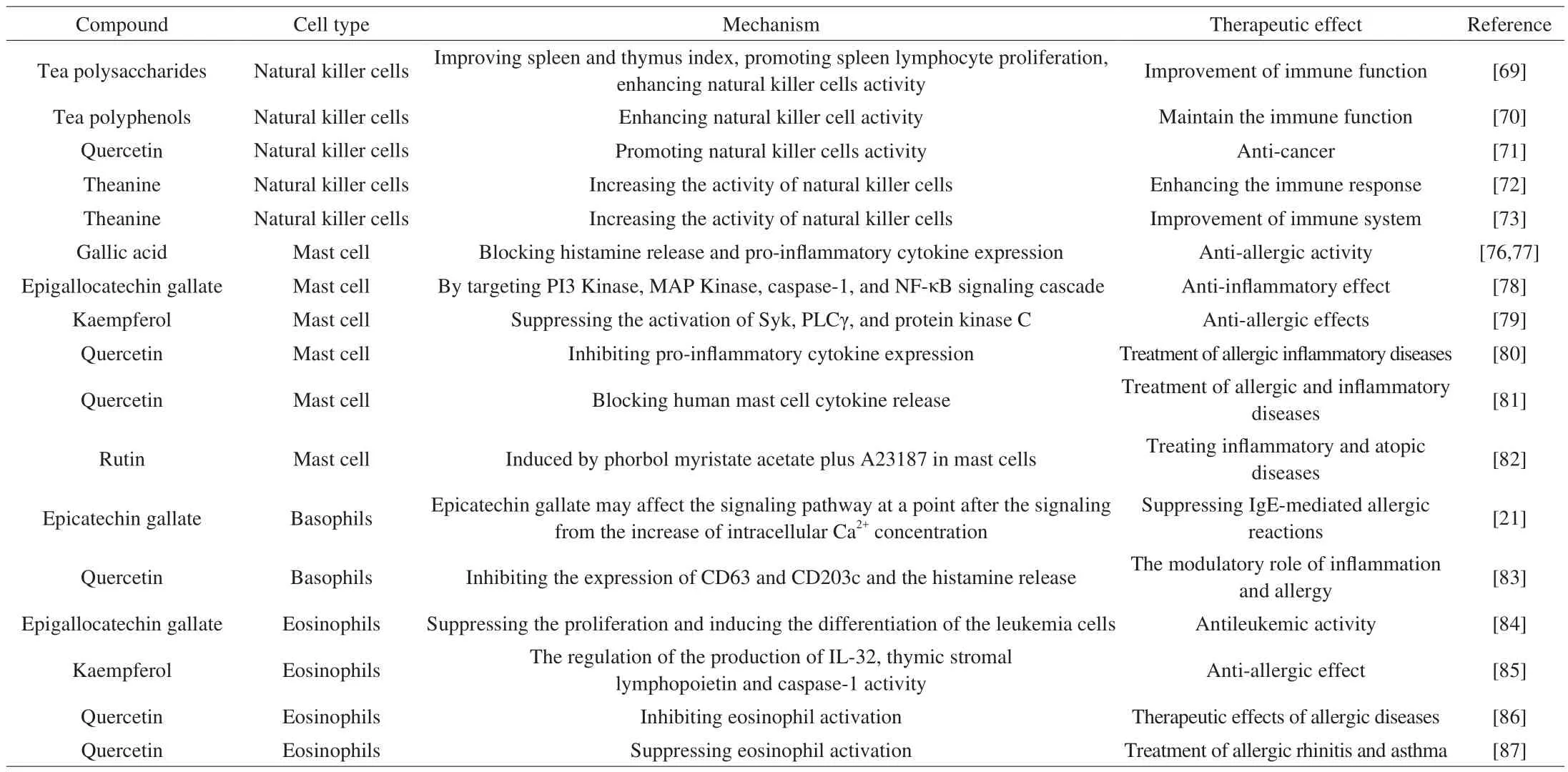
Table 2Activity and effects of tea and tea’s components in natural killer cells, mast cells, basophils and eosinophils.
Tea polysaccharides improve immune function by improving spleen and thymus index, promoting spleen lymphocyte proliferation,enhancing natural killer cell activity [69]. Consuming tea polyphenols can boost natural killer cell activity and keep the immune system functioning in the elderly [70].
Quercetin could enhance the effectiveness of natural killer cell-based cancer immunotherapy by inducing the natural killer group 2D ligands on the surface of cancer cells, which would suppress the expression of heat shock proteins 70 [71].
Supplementing with theanine reduces the attenuation of natural killer cell activity caused by resistance exercise in well-trained men [73].Natural killer cells were shown to be more active in the athletes supplemented with theanine in the same study [73].
2.3 Mast cells, basophils, and eosinophils
Mast cells, basophils, and eosinophils are central effector cells in inflammation response, as well as in innate immunity [74]. These cells have different development, anatomical location and life span but share many similarities in their mechanisms of activation and type of mediators [75]. The effects of tea and its constituents on mast cells,basophils and eosinophils are detailed in Table 2.
Gallic acid inhibits mast cell-derived inflammatory allergic reactions by blocking histamine release and pro-inflammatory cytokine expression [76,77]. By targeting PI3 Kinase, MAP Kinase, caspase-1,and the NF-κB signaling cascade in mast cells, epigallocatechin gallate functions as a natural therapy for preventing and treating receptor activator of NF-κB ligand-mediated inflammatory disorders [78].Kaempferol has antiallergic effects on antigen-induced mast cells by inhibiting the activation of Syk, PLCγ, and protein kinase C, as well as mast cell degranulation [79]. In human mast cell lines, quercetin inhibits the expression of pro-inflammatory cytokines via modulation of NF-κB and p38 MAPK. Thus, quercetin has therapeutic potential for allergic diseases involving mast cells [80]. Quercetin also inhibits the release of mast cell cytokines, making it an effective treatment for allergic and inflammatory diseases [81]. Thymic stromal lymphopoietin (TSLP)-positive mast cells were inhibited by rutin in an ear oedema model induced by phorbol myristate acetate. These findings show that by inhibiting TSLP, rutin could be useful in the treatment of inflammatory and atopic illnesses (Fig. 3) [82].

Fig. 3 Schematic diagram of proposed regulation of TSLP by rutin.
Epicatechin gallate may act on a signaling pathway in human basophils that controls degranulation in response to an increase in intracellular Ca2+concentration [21]. In basophils triggered by anti-IgE or the ionophore, quercetin suppressed the expression of CD63 and CD203c, as well as histamine release. It provides new information regarding this natural compound’s modulatory role in cells of inflammation and allergy [83].
Epigallocatechin gallate inhibits the proliferation and induces differentiation of leukemia cells in the human eosinophilic cell line EoL-1, demonstrating antileukemic action [84]. Kaempferol has anti-allergic effect by the inhibition of the production of IL-32, thymic stromal lymphopoietin and caspase-1 activity in eosinophil cell [85].Inhibition of eosinophil activation with quercetin, especially chemokine production, leads to inhibition of the development of inflammatory responses in eosinophils [86]. Quercetin inhibits eosinophil activation generated by stem cell factor stimulation,making it a suitable candidate for use as a supplement to treat eosinophil-mediated illnesses such allergic rhinitis and asthma [87].
2.4 Neutrophils
Neutrophils are the most abundant innate immune effector cells of the human immune system [88]. The effects of tea and its constituents on neutrophils are detailed in Table 3.

Table 3Activity and effects of tea and tea’s components in neutrophils and dendritic cells.
Tea polyphenols have a substantial immunomodulatory influence on neutrophil activity in obese people [89]. The anti-inflammatory properties of tea polyphenols are mainly attributed to their interaction with neutrophils and gastric epithelial cells [90]. In neutrophils, gallic acid inhibits ROS release and formation of neutrophil extracellular traps,as well as reducing lipopolysaccharide’s anti-apoptotic effects [91].Gallic acid also exerts anti-inflammatory properties in part by inhibiting PDE4 activity and thus enhancing IL-6 and reducing TNF-α production in neutrophils [92].
Epigallocatechin gallate is a potent anti-inflammatory compound with therapeutic potential, as it inhibits apoptosis of activated neutrophils, reduces chemokine-induced neutrophil chemotaxis,and blocks neutrophil-mediated angiogenesis in an inflammatory angiogenesis model [93]. Moreover, epigallocatechin gallate suppressed neutrophil infiltration by suppressing chemokine production at the inflammatory site [94].
Through the ROS-PAD4 (PAD4, peptidyl arginine deiminase type IV) pathway, kaempferol prevents neutrophil extracellular trap formation and tumor spread [95]. The pro-inflammatory factor IL-6 plays a crucial role in early phases of inflammation. Quercetin has an anti-inflammatory action via inhibiting the production of IL-6 by neutrophils [96]. Souto et al.[97]showed quercetin can inhibit neutrophil recruitmentin vivoandin vitroby suppressing actin polymerization, and its possible usefulness to diminish excessive neutrophil migration during inflammation. Inflammatory diseases can be prevented and treated with quercetin by decreasing neutrophil susceptibility to pro-inflammatory factors [98]. In addition, rheumatoid arthritis may be treated with quercetin by inhibiting neutrophil in filtration and reducing plasma levels of inflammatory cytokines [99].Rutin has a therapeutic strategy for neutrophil-mediated inflammatory/autoimmune diseases, through inhibiting NO and TNF-α productions, as well as myeloperoxidase activity in activated human neutrophils [100].
The viability of co-cultured neutrophils was dramatically enhanced when lipopolysaccharide-primed mesenchymal stem cells were treated with caffeine, thus caffeine can regulate immunity and inhibit the inflammatory response [101]. Caffeine can increase the phagocytosis of neutrophils and diminish the production of reactive oxygen substances in mesenchymal stem cells [102]. Theanine reduces the expression of PECAM-1 (platelet endothelial adhesion molecule-1) in blood vessels and the generation of pro-inflammatory cytokines in neutrophils, resulting in anti-inflammatory actions [103].
2.5 Dendritic cells
Dendritic cells play critical roles in activating innate immune cells and initiating adaptive immune responses [104]. The effects of tea and its constituents on dendritic cells are detailed in Table 3.
Gallic acid inhibits the release of IL12-p40 and the functional surface markers CD40, CD80, CD83, and CD86 from cytokine cocktail-activated monocyte-derived dendritic cells. Gallic acid may also reduce the amount of hydrocortisone needed to stop dendritic cells from being activated [105]. Epigallocatechin gallate has an effect on the phenotype of the developing dendritic cells, and promote cell apoptosis. By decreasing the expression of CD83, CD80, CD11c,and MHC class II, epigallocatechin gallate impaired dendritic cell antigen presentation. In addition, epigallocatechin gallate can inhibit the endocytotic ability of immature dendritic cells. As a result, epigallocatechin gallate may prove useful in treating allergic and autoimmune disorders as well as allograft rejection [106]. In IFN-γ-stimulated murine dendritic cells, epigallocatechin gallate decreased indoleamine 2,3-dioxygenase (IDO) expression through inhibiting signal transducer and activator of transcription 1 (STAT1) activation and COX-2 expression. As a result,epigallocatechin gallate appears to be a promising novel pharmacological agent for IDO modulation as well as a therapeutic adjuvant for disorders involving dendritic cells [107]. UV-B irradiation inhibits dendritic cells, but epigallocatechin gallate can reverse this effect. This function appears to have a link to the protective impact of costimulating molecules on dendritic cells surface expression and IL-10 and IL-12 secretion levels [108].In comparison with the immunized mice with ovalbumin, kaempferol increased the infiltration of CD11c+MHCII+dendritic cells, while suppressing caspase-1 protein expression, suggesting anti-inflammatory effect and potential for immunostimulatory action [109]. Kaempferol suppressed the production of cytokines and chemokines from lipopolysaccharide-stimulated dendritic cells. Also, kaempferol adversely affected dendritic cell maturation. Moreover, kaempferol inhibited the ability of lipopolysaccharide-stimulated dendritic cells to activate Ag-specific T cells. According to these findings,kaempferol may be useful in treating chronic inflammatory and autoimmune diseases [110]. Quercetin is an immunomodulatory agent capable of altering the phenotype and function of human dendritic cells, changing the balance from inflammation to resolution [111].Activation of dendritic cells is inhibited by quercetin by regulating the expression of disabled 2 (Dab2) protein [112]. By inhibiting dendritic cell activation and activity, quercetin could be used to prevent and treat chronic inflammation, autoimmunity, and transplantation [113].By reducing COX-2 levels, balancing IL-10/IL-12 secretion, and restoring the activation of dendritic cells, theanine enhances tumor immunosurveillance [114].
3. Effects on the adaptive immune system
3.1 T cells
T cell is a type of lymphocyte, it has the function of establishment and maintenance of immune responses, homeostasis and memory [115]. The effects of tea and its constituents on T cells are detailed in Table 4.

Table 4Activity and effects of tea and tea’s components in T and B cells.
The study showed that treatment with green tea extract decreased antigen-specific IgE production while increasing the proportion of CD4+CD25+regulatory T lymphocytes in the spleen, which indicates that green tea extract may play a role in treating allergic reactions [116].In vivo, tea polyphenols can increase transplant survival while also inhibiting transplant-reactive T cell function [117]. Tea polyphenols have a positive therapeutic effect on adult T cell leukemia patients by inhibiting the proliferation of peripheral blood T lymphocytes [118].Gallic acid can reduce excessive inflammatory responses by promoting the differentiation of regulatory T cells [119].
Epigallocatechin gallate induces the release of IL-10 by altering histone acetylation–deacetylation and reducing NF-κB expression,thereby enhancing the number and anti-inflammatory activity of Tregs [120]. Epigallocatechin gallate exerts anti-inflammatory effect by reducing the expression of CD11b on CD8+T cells and inhibiting their infiltration into inflammation sites [121]. Human primary T cells were reduced in cytokine production after treatment with epigallocatechin gallate, the anti-inflammatory mechanism is associated with the inhibition of activator protein (AP)-1 activity [122].Additionally, the anti-inflammatory effect of epigallocatechin gallate is mediated through suppressing signal transducer and activator of transcription 3 (STAT3) proteins and Th17 cell differentiation [123].In asthmatic mice, epigallocatechin gallate inhibited the inflammation of the airways by decreasing the percentage of Th17 cells and increasing the number of T cells. The anti-inflammatory effect of epigallocatechin gallate is achieved via the TGF-β1 signaling pathway [124].By increasing the levels of cell surface markers for T cells in WEHI-3-derived leukemic BALB/c mice, epigallocatechin gallate can promote the immune response [55]. Epigallocatechin gallate also can inhibit T cell proliferative response to both polyclonal and antigen-specific stimulation. The consumption of epigallocatechin gallate may help reduce the pathogenesis of some autoimmune diseases [125]. Epigallocatechin gallate is helpful to treat autoimmune and inflammatory disorders, because it impaired IL-2/IL-2 receptor signaling pathways in T cell [126]. Trough modulating the downstream regulator STAT3 and signal transducer and activator of transcription 5 (STAT5), epigallocatechin gallate can control the number of effector T cells and naive T cells, restore the balance of Th17 cell/regulatory T cells. As a result, epigallocatechin gallate has been shown to be a useful therapeutic natural medicine in the treatment of cardiac extracellular matrix remodeling and the improvement of heart function [127].
In vivo, kaempferol inhibits multidrug resistance protein-1 activity in activated T cells to protect against T cell-mediated diseases(Fig. 4) [128]. Kaempferol reduces Th1 cytokine production and hence suppresses the proliferation or creation of CD8+CTLsin vitro,making it a promising treatment option for acute graft-versus-host disease [129]. The current study’s findings imply quercetin has cancer-preventive potential, since it reduces cell survival,inflammation, and angiogenesis in murine T cell lymphoma through regulating Akt signaling [130]. Quercetin reduces experimental allergic encephalomyelitis by inhibiting IL-12 signaling and Th1 development, suggesting that it might be used to treat multiple sclerosis and other autoimmune illnesses caused by Th1 cells [131].Rutin inhibits intestinal inflammation associated with chronic, T lymphocyte dependent colitis by releasing quercetin and acting on mucosal and lymph node T cells [132].
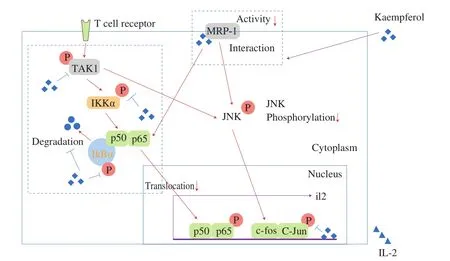
Fig. 4 Diagram of possible mechanisms of regulatory effect of kaempferol on T cell activation.
3.2 B cells
B cells, also known as immunoglobulins, produce antibodies against foreign antigens, such as pathogens and allergens that trigger hypersensitivity reactions [133]. Activity and effects of tea and its constituents in B cells were summarized in Table 4.
Epigallocatechin gallate has therapeutic effects on arthritis by inhibiting B lymphocyte proliferation and inducing B lymphocyte apoptosis [134]. Through binding to CD11b on B cells,epigallocatechin gallate suppresses B cell adhesion and migration.Thus, epigallocatechin gallate is a promising drug for the treatment of allergic and autoimmune diseases [135]. Caffeine can inhibit the production of IL-1 or PGE2, affecting the proliferation of B and T cells, so as to exert Immunomodulatory effects [136].
4. Effects on the intestinal immune system
The intestine is the largest compartment of the immune system.More and more researches suggest that intestinal immunological systems are increasingly linked in disease development elsewhere in the body [137]. In addition to being a nutritious beverage, tea has an important function in the balance between intestinal immunological tolerance and gut microbiota maintenance [138]. Thus, the section provides a new summary regarding the effects of tea and its constituents on the intestinal immune system, and how to treat and prevent diseases (Table 5).

Table 5Activity and effects of tea and tea’s components in intestinal immune system.
The study found that tea polysaccharides intake affected the growth state of some gut microbiota and further improved the intestinal environment by regulating the immune pathway and secondary metabolites [139,140]. Tea polyphenols can be applied to increase the beneficial flora in the intestinal tract, thereby inhibiting the harmful bacteria and adjusting the structure of the intestinal flora. The intestinal microbiota promotes the release of bioactive metabolites from tea polyphenols, which have the ability to regulate the mood and sleep while improving immunity [141]. In addition to influencing microbes in the gastrointestinal tract, tea polyphenols are also metabolized by gut microbes. Accordingly, tea polyphenols reduce inflammation and non-specific immune responses [142]. Gallic acid appears to enhance the intestinal immune response through the following mechanisms: reduced diarrhea, positive modulation of intestinal shape, increased sIgA content, and downregulation of pro-inflammatory cytokines in the ileal mucosa [143].
In mice with obesity induced by a high-fat diet, epigallocatechin gallate significantly improved intestinal mucosal immunity and prevented the development of nonalcoholic fatty liver disease [144].Epigallocatechin gallate derived metabolites produced by gut microbiota could be modifying the effector functions of immune T cells by different mechanisms such as upregulating the miRNAs, cytokine production, or Ca2+activity(Fig. 5) [145]. Cold-induced intestinal oxidative damage can be reduced by kaempferol, while immunity is improved as well [146].Kaempferol can enhance intestinal barrier integrity and reduce inflammatory responses in the gut, by inhibiting the activation of TLR4/NF-κB pathway [147]. Intestinal injury can be alleviated by quercetin, by regulating intestinal oxidative status and improving intestinal immune system function [148].
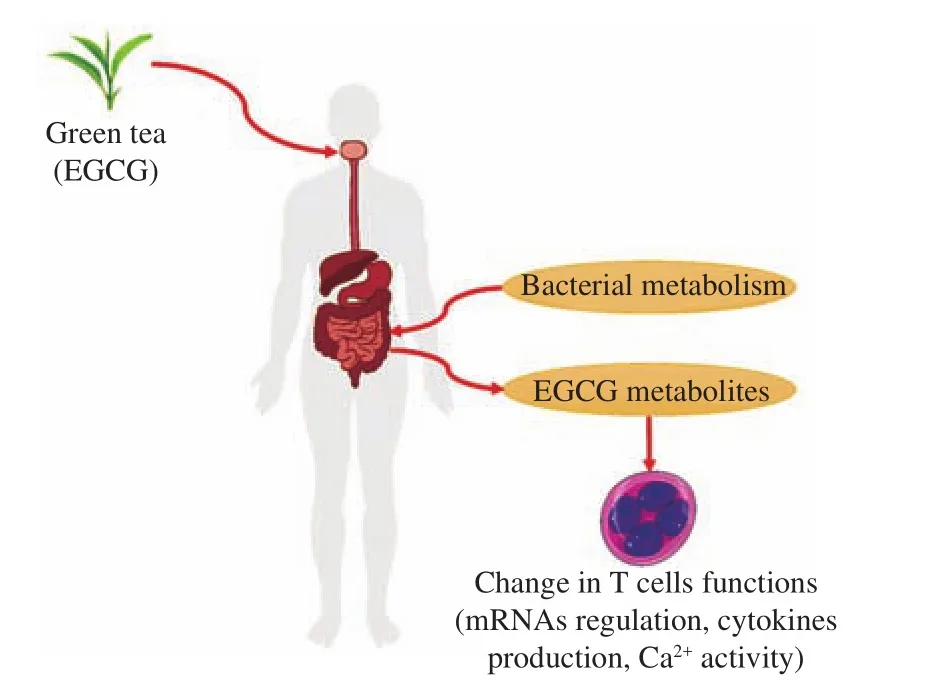
Fig. 5 The mechanisms of epigallocatechin gallate and immune responses.
Theanine exhibited a beneficial effect on intestinal bacteria by supporting beneficial organisms such asLactobacillusand decreasing harmful organisms such asClostridium. By lowering the mRNA expression of toll-like receptors (TLRs) (TLR-2 and TLR-4)and cytokines (TNF-α, IFN-γ, and IL-2) in the intestinal mucosal, theanine can modify the immune response and reduce inflammation [149]. By improving cholesterol synthesis in the liver and inhibiting gluconeogenesis in the colon, theanine regulates short-chain fatty acids metabolism and improves intestinal mucosal immune function [150].
5. Conclusions and perspectives
A variety of chemical components are found in green tea, including polyphenols, purine alkaloids, amino acids and polysaccharides, etc. In green tea, various compounds act on different immune cells or even the same type of cell, causing diverse effects on the immune system (Fig. 6). According to the current research results,we speculate that green tea showed greater immunomodulatory potential due to the synergistic effects on innate immunity and adaptive immunity of different compounds. Moreover, it has been shown that green tea affects immune responses by modifying gut microbiome environments, for example, by moderating green tea into different metabolites, and it will further result in immune regulation.While studies on the mechanisms underlying the immunomodulatory effects of green tea are still in their infancy, affecting immune function by green tea will offer a promising alternative to treating and preventing multiple diseases. In the main components of green tea,polyphenols are the most abundant and immunocompetent substance.Among polyphenols, epigallocatechin gallate is the most abundant polyphenolic compound, exerts effectively various therapeutic effects through immunomodulatory properties. Moreover, further studies are required to identify additional or more effective components or ingredients of green tea with immunomodulatory effects, to elucidate their mechanisms of action, to improve their biological efficacy, and to expand their applications in the prevention and therapy of a wide variety of diseases.
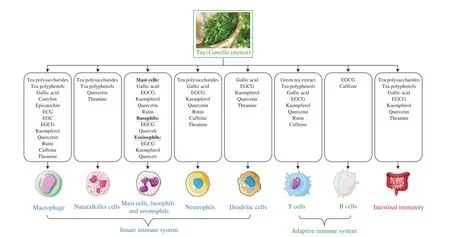
Fig. 6 Effect of tea & tea’s components on the immune system.
conflict of interest
The authors declare that they have no known competing financial interests or personal relationships that could have appeared to influence the work reported in this paper.
Acknowledgments
This study was supported by College Student Innovation and Entrepreneurship Training (202110069122), Tianjin Key R&D Plan-Key Projects Supported by Science and Technology(19YFZCSN00010), and Tianjin Agricultural Science and Technology Achievements Transformation and Promotion Project (202101120).
Ethical approval
There are no ethical issues associated with this publication.
- 食品科学与人类健康(英文)的其它文章
- Hypoglycemic natural products with in vivo activities and their mechanisms: a review
- Bacteroides utilization for dietary polysaccharides and their beneficial effects on gut health
- Capsular polysaccarides of probiotics and their immunomodulatory roles
- Natural compounds may contribute in preventing SARS-CoV-2 infection: a narrative review
- A review on current and future advancements for commercialized microalgae species
- Effects of silkworm pupa protein on apoptosis and energy metabolism in human colon cancer DLD-1 cells

